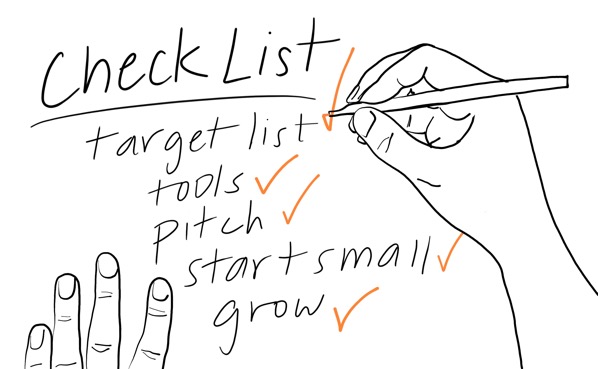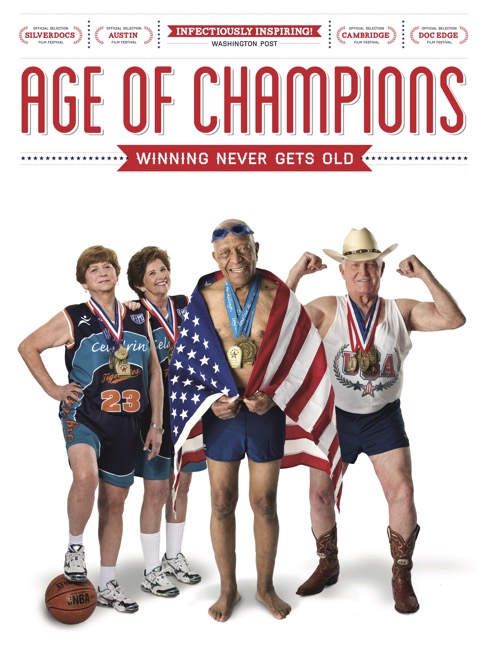THE DISTRIBUTION BULLETIN ISSUE #45
By Keith Ochwat

Partnerships are powerful tools that can enable you to maximize your film’s reach and revenue.
The dynamics of distributing documentaries have changed dramatically. In years past, a single distribution deal might have been enough to make your film successful. Today it’s critical to build direct connections with audiences and organizations who align with your film.
Enter partnership strategy. I first learned how to build partnerships during the distribution of Age of Champions, my documentary about the Senior Olympics. We had a Netflix deal, a PBS national broadcast, and a Kanopy educational release, but the keys to our success were partnerships with allies that shared a passion for our film’s message. Working with AARP, Cigna Health, and other nonprofit groups in the senior living worlds, I was able to create a campaign that resulted in over 3,000 community screenings and generated $1,543,000—only $64,000 of it came from our distributors. 96% ($1,479,000) came directly from the promotion and support of our partners.
Successful partnerships can give you the control, flexibility, and connection to the core audiences you need to thrive in today’s environment. Since my Age of Champions experience, I’ve worked with Peter to help hundreds of other filmmakers build their own partnership strategies.
Whether you’re creating a partnership with a nonprofit, a company, or an advocacy group, understanding how to effectively pitch partners is essential.

Why Pitch Partners?
A good partner can provide funding, help raise critical awareness, and generate substantial impact. The two most important qualities of major partners are:
- they are aligned with the issue or topic(s) central to your film
- they have an active audience that will be receptive to your film’s message
Partners come in all shapes and sizes, including:
- A nonprofit advocacy group
- A Fortune 500 company
- An Instagram influencer that backs you financially and opens doors to more support
- The organizer of a conference of academics focused on issues connected to your film
- Government officials, departments, and policy makers
- Foundations committed to support causes related to your film
If partners are who you work with, partnerships are how you work with them. The most important aspect of any successful partnership is that it is mutually beneficial! It’s all about the win-win.
STEP 1: Make Your Target List
The first step to pitching partners is identifying the right ones to approach. You should make a list of influential partners that have a track record of supporting the issues central to your film.
Your film’s central issues are its essential themes and message—not simply the topic or storyline of your film. For example, although Age of Champions tells the stories of senior athletes, our central issue was active aging. By focusing on the most prominent and influential companies and nonprofits that had a history of supporting programs, conferences, and other initiatives related to active aging, we were able to prioritize our research.
Pro tip: A good way to find prospective partners is to do reverse research. This is the most effective way to multiply one good potential partner to highlight several more. First, identify an organization that is a promising partner, then work backwards to find other organizations in their network. For example, if you find a nonprofit that could be an excellent partner, look at the affiliations of their board members. The companies and organizations they are part of could also be interested in your film.
You can also:
- Look up any nonprofit’s tax forms online (they are called a Form 990) to find out who funds them
- Look at the companies that sponsor related conferences
- Find out which celebrities are involved in causes related to your central issues
- Identify which companies are buying advertising in niche media outlets relevant to your film’s central issues
- Research foundations and other nonprofits that fund or operate relevant programs and initiatives
If a potential partner has a track record of supporting the issues relevant to your film, chances are they’ll want to hear about your distribution plans—so put them on your list!
When I was building my partners target list for Age of Champions, I looked for prominent and influential entities that already had a clear track record of supporting programs, conferences, and other initiatives related to active aging. I assembled a list of over 300 potential partners, which fell naturally into different groups with similar characteristics. I whittled them down by emailing or calling two organizations in each group to gauge their interest and assess the overall potential of their group. I then focused on certain groups and eliminated others.
When reaching out to a potential partner, I was looking for unbridled enthusiasm for my film. A lukewarm response wouldn't do. It's important to determine which partners are most interested in your film and the possibility of collaborating. The most common mistake filmmakers make is creating a large list of potential partners and then trying to pursue them all with an equal amount of energy. This is a great way to exhaust yourself and give up before connecting with the right potential partners.
Over the course of my research and outreach via email and phone calls, 300 possibilities became 100 then 25 promising potential partners. By the end of our distribution, I had developed meaningful relationships with six partners—five of whom had long track records of engagement in the active aging world.

STEP 2: Give Them Your Best Ideas
I next focused on coming up with ideas for mutually beneficial ways to work together. Note: a prospective partner should never get the impression that you view them merely as an avenue for promotion to their network! They should value your partnership as providing them with something highly desirable in its own right. That’s where your good ideas come in—and your suggestions should be based on the goals and characteristics of your partner.
Effective partnerships leverage the strengths of a partner and respect its limits. Different partners bring different assets. Be sure when you are brainstorming to focus on these assets and their potential. Some partners have large networks they can promote your film to. Others have deep pockets. A partnership with a large company will likely include financial support. While most nonprofits won’t be able to provide funding, they can provide very valuable in-kind support, which can include leveraging their massive email lists.
You can also build partnerships which bring together multiple organizations with complementary strengths. Imagine you’ve got a nonprofit partner that has a valuable national network for raising awareness but can’t provide any funding. At the same time, there’s a company or foundation that has resources but no network to promote your film. If those organizations are interested in a joint collaboration—bullseye.
This complementary strength approach worked for a feature documentary Peter and I advised about narrative medicine—the idea that one’s physical and mental health can benefit from revisiting the stories we tell ourselves. The film is called Is Your Story Making You Sick? We contacted an enthusiastic potential partner, the International Fellowship in Integrative Medicine, which connects 4,500 medical professionals interested in narrative medicine from around the world. The problem: they had no budget for a partnership. We then looked for the biggest funders of the narrative medicine movement and identified the Andrew Weil Foundation, which has a track record of supporting this area of research. They were excited about our film and were open to supporting a partnership with the International Fellowship. We applied for and received a $7,500 grant to do one virtual screening event, including the film and a live Zoom training session with the Fellowship’s large global network.

STEP 3: Prepare Your Tools and Pitch
Consider this: chances are your prospective partners have never partnered with a film. This means that you need to clearly and simply explain what it entails and why a partnership will benefit them.
Many promising partnership conversations never get past this fateful phrase, “we’re interested in your film but will get back to you on how we can get involved.” Another common dead end is for a prospective partner to make a suggestion that is easy for them but nearly useless to you. (“We’ll post your trailer on our social media.”)
The way to get ahead of these roadblocks is to clearly articulate your ideas for what the partnership will consist of, and how it will work. Be sure to emphasize how it will be good for your potential partner—the “win-win” message is critical. This will help you establish a partnership on your terms rather than agreeing to what is least inconvenient for your partner.
Pick up the phone and reach out. Sharing your ideas on the phone rather than over email, will help you learn what is possible and when pivoting is needed.
Emails are really good for quickly reaching a lot of people—casting a wide net. You can make an initial introduction and hopefully get someone to agree to speak with you on the phone. Phone calls are important for building a relationship and for dialogue. A partnership can’t happen if you don't have some level of relationship with people at the partnering organization. You won't build that relationship unless you listen to them and understand what their needs are and how your film can help them. You goal is to lead the conversation with a clear explanation of the opportunity you’re offering and how they will benefit.
Another powerful tool to pitch partners is sharing a virtual event page. Don't just tell a potential partner how you might work together—show them! Director Ward Serrill has used this tactic very effectively when approaching nonprofit organizations in the classical music world. He offers them virtual screenings of his film, The Bowmakers, along with a win-win split of ticket sales, donations, and DVD sales. Ward creates a sample virtual event page to make clear how a partnership will work. By giving these entities a valuable way to raise money and engage donors and supporters during a time when live events aren’t possible, he has generated significant revenues and ignited broader interest in his film. Check out a virtual event page for The Bowmakers.

STEP 4: Follow Up!
Here’s where you get to practice the skills you’ve no doubt learned in other aspects of filmmaking – being polite and persistent.
Key decision makers in partner organizations are busy. After your initial contact/conversation, you must be willing to call and email again and again with pleasant but regular reminders that you have a great opportunity to share.
Polite persistence is your best strategy. If you aren’t breaking through, diversify your outreach and try the second or third in command as a way to get the conversation started. If you’re convinced that you may have a meaningful partnership on your hands, continue to follow up. Try to provide new information each time you check in. Always give the impression that you and your team will add value to what they’re doing.
STEP 5: Start Small and Grow
Starting small and delivering on what you promised is the first step in any meaningful partnership. Even if your film is a perfect fit, a partner usually won’t write the large check or agree to a prominent virtual event right off the bat.
Building trust comes from doing what you promise and meeting or exceeding their expectations each step of the way. One way to foster trust is by sharing the positive feedback you’ve received for your initial collaborations. Show your partner that your film is resonating with the people in their network. A quote or testimonial from a colleague or relevant influencer can help you grow your partnership.
I’ve often found that even if you have a big vision for a partnership, you may need to start small and grow. While it can be frustrating to go slow with partnerships, I’ve seen this pay off on many occasions. For example, I initially I pitched AARP on sponsoring a 20-state semi-theatrical tour for Age of Champions. They said no. I scheduled a follow-up call and pitched them on sponsoring just one event in a city of their choice. We ended up doing a special screening event in Austin, TX with a Q&A. The Texas state AARP director was ecstatic about the response and gave a positive report back to headquarters. After two more one-off events in different cities that AARP sponsored (followed by a testimonial from the local AARP director), I went back to HQ and pitched them once more on the 20-state tour of the film. This time they said yes!
-----
I hope these five steps will help you on your journey identifying and pitching partners. Partnerships were hands down our most effective tool during the distribution of Age of Champions. In my work advising filmmakers on connecting with their own partners, I have seen the impact an effective partnership strategy has on raising critical awareness for a film.
However varied partners may be, what’s constant is that meaningful partnerships will transform your distribution. Filmmakers I’ve advised have grown their audience and generated significant revenue partnering with companies like 23andMe, professional groups like the National Association of Rehabilitation Nurses, and arts organizations like the Seattle Orchestra and Hauser & Wirth. Each of these partners transformed the filmmaker’s ability to connect with a national or global audience and to generate revenue.
This guide is meant to give you knowledge but also the confidence to try an approach to distributing your film that is outside of the norm. It can be intimidating to be on the frontier of distribution, but time and again, I've seen this strategy work—and work wonders.
———————————
Keith is the Founder of Show&Tell, a virtual screening platform. To learn more about hosting a screening of your film or learn the fundamental principles of how to launch an effective virtual event, visit www.showandtell.film.
Check out this sample Show&Tell virtual event for a feature documentary that has held 22 events raising $66,000.
© 2021 Keith Ochwat
Illustrations by Sofia Lacin